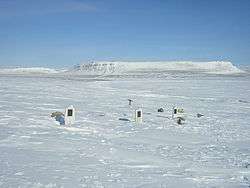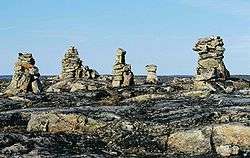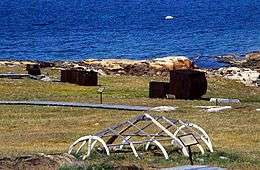List of National Historic Sites of Canada in Nunavut
This is a list of National Historic Sites of Canada (French: Lieux historiques nationaux du Canada) in the territory of Nunavut. There are 12 National Historic Sites designated in Nunavut, one of which is administered by Parks Canada (identified below by the beaver icon ![]() ).[1][2]
).[1][2]
This list uses names designated by the Historic Sites and Monuments Board of Canada, which may differ from other names for these sites.
National Historic Sites
| Site | Date(s) | Designated | Location | Description | Image |
|---|---|---|---|---|---|
| Arvia'juaq and Qikiqtaarjuk [3] | 1995 | Arviat and Sentry Island 61°08′23″N 093°59′36″W / 61.13972°N 93.99333°W |
A traditional summer camp of the Paallirmiut Inuit and an archaeological site on Hudson Bay; representative of the cultural, spiritual and economic life of the Inuit in the Arviat region | ||
| Beechey Island Sites[4] | 1845–46 (wintering site), 1852–54 (search expeditions) | 1993 | Beechey Island and Devon Island 74°43′N 091°51′W / 74.717°N 91.850°W |
Sites associated with Arctic exploration, including the wintering site of Franklin's lost expedition and a base for subsequent search expeditions |  |
| Blacklead Island Whaling Station[5] | 1860 (established) | 1985 | Blacklead Island 64°58′59″N 066°12′00″W / 64.98306°N 66.20000°W |
One of the most important whaling stations and wintering sites in Cumberland Sound from the 1860s until the early 20th century; a good example of a contact-period Inuit village |  |
| Bloody Falls[6] | 1700 BCE (c.) (human occupation) | 1978 | Kugluk/Bloody Falls Territorial Park 67°44′36″N 115°22′03″W / 67.74333°N 115.36750°W |
Archaeological remains on river terraces of pre-contact hunting and fishing sites; a record of the presence of Pre-Dorset, Thule, First Nation and Inuit peoples over the last 3000 years |  |
| Fall Caribou Crossing[7] | 1995 | Kivalliq Region 63°38′37″N 096°02′58″W / 63.64361°N 96.04944°W |
A section of the lower Kazan River which has witnessed centuries of inland caribou hunting; symbolic of the cultural, spiritual and economic life of the Inuit in the region | ||
| Igloolik Island Archaeological Sites[8] | 2000 BCE (c.) (human occupation) | 1978 | Igloolik Island 69°23′N 081°40′W / 69.383°N 81.667°W |
Nine archaeological sites dating from Dorset and Pre-Dorset occupations, demonstrating 4000 years of human activity; also the wintering site for William Parry in 1821 and the base of the Fifth Thule Expedition of 1921–24 | |
| Inuksuk[9] | 1969 | Foxe Peninsula 64°34′19″N 078°10′17″W / 64.57194°N 78.17139°W |
100 inuksuit standing on a treeless headland; a testament to the ingenuity and artistry of the Inuit |  | |
| Kekerten Island Whaling Station[10] | 1857 (established) | 1985 | Cumberland Sound 65°42′N 065°48′W / 65.700°N 65.800°W |
The remains of a whaling station, as well as a burial ground and a shipwreck; symbolic of whaling in the Eastern Arctic and of the economic and cultural impact of the whaling on the Inuit in the region |  |
| Kodlunarn Island[11] | 1576–78 (expeditions) | 1964 | Frobisher Bay 62°49′03″N 065°25′44″W / 62.81750°N 65.42889°W |
The ruins of a stone house, earthworks and mining excavations from Martin Frobisher's gold mining expeditions to the Canadian Arctic Archipelago | |
| Port Refuge[12] | 1978 | Grinnell Peninsula 77°00′17″N 096°09′49″W / 77.00472°N 96.16361°W |
Archaeological sites dating to prehistoric occupation, including a Thule winter village and remains of Pre-Dorset dwellings, including evidence of Thule contact with the medieval Norse colonies of Greenland | ||
| Wreck of HMS Breadalbane[13] | 1853 (wreck) | 1983 | Beechey Island 74°43′N 091°51′W / 74.717°N 91.850°W |
The wreck of the ship involved in the search for Franklin's lost expedition | |
| Wrecks of HMS Erebus and HMS Terror |
1845–46 (expedition) | 1992; joined park system in 2015 | Queen Maud Gulf north by northeast of O'Reilly Island 68°14′09″N 98°42′52″W / 68.235931°N 98.714376°W[16] |
The remains of the HMS Erebus and HMS Terror, the two ships of Franklin's lost expedition in 1845–46, believed to have been trapped and wrecked by pack ice; official location includes remains of HMS Erebus (Discovered at Wilmot and Crampton Bay in September 2014); and remains of HMS Terror (Discovered at Terror Bay in September 2016) | |
See also
| Wikimedia Commons has media related to National Historic Sites of Canada in Nunavut. |
References
- ↑ "Nunavut". Directory of Federal Heritage Designations. Parks Canada. Retrieved 28 October 2013.
- ↑ Nunavut, National Historic Sites of Canada - administered by Parks Canada
- ↑ Arvia'juaq and Qikiqtaarjuk. Canadian Register of Historic Places. Retrieved 28 October 2013.
- ↑ Beechey Island Sites. Canadian Register of Historic Places. Retrieved 29 October 2013.
- ↑ Blacklead Island Whaling Station. Canadian Register of Historic Places. Retrieved 29 October 2013.
- ↑ Bloody Falls. Directory of Federal Heritage Designations. Parks Canada. Retrieved 29 October 2013.
- ↑ Fall Caribou Crossing. Canadian Register of Historic Places. Retrieved 29 October 2013.
- ↑ Igloolik Island Archaeological Sites. Canadian Register of Historic Places. Retrieved 29 October 2013.
- ↑ Inuksuk. Canadian Register of Historic Places. Retrieved 30 October 2013.
- ↑ Kekerten Island Whaling Station. Canadian Register of Historic Places. Retrieved 30 October 2013.
- ↑ Kodlunarn Island. Canadian Register of Historic Places. Retrieved 30 October 2013.
- ↑ Port Refuge. Canadian Register of Historic Places. Retrieved 30 October 2013.
- ↑ Wreck of HMS Breadalbane. Canadian Register of Historic Places. Retrieved 30 October 2013.
- ↑ Erebus and Terror. Canadian Register of Historic Places. Retrieved 29 October 2013.
- ↑ 2015 April Dive Results for Franklin Vessel HMS Erebus, Parks Canada, May 13, 2015
- ↑ Wrecks of HMS Erebus and HMS Terror National Historic Site, Site Management, Superintendent's Order, July 2015
This article is issued from Wikipedia - version of the 12/2/2016. The text is available under the Creative Commons Attribution/Share Alike but additional terms may apply for the media files.
